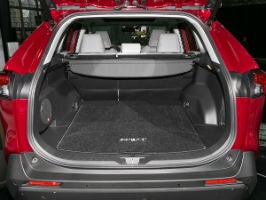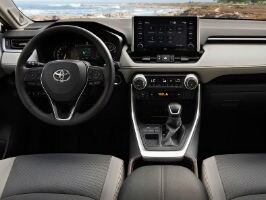 |  |
Honda CR-V and Toyota RAV4
Both of these "Small Sport Utility Vehicles" are about the same size and offer similar value, space, and fuel economy. They are the undisputed sales leaders in this competitive segment, and the mantle of volume leadership seesaws between them throughout the year. Comparably equipped in mid-level trim, around $29,000 will buy either car and deliver a safe, stylish, and practical vehicle with a great reputation for quality. However, only the RAV4 comes with free maintenance for two years or 25,000 miles.
Both vehicles began life on the platforms of compact sedans (Civic and Corolla) and then received a lift kits and lots of rugged trim. Buy either one with front-wheel-drive or all-wheel-drive, though the safety and performance benefits of all-wheel-drive are well worth the small price premium.
CR-V was "refreshed" for the 2020 model year. Toyota introduced an all-new RAV4 for 2019, and improved significantly in areas where it lagged the fierce competition in this segment. Fuel economy improved even though the new engine generates over 200 horsepower. The new eight-speed transmission is smoother and more-fuel efficient, and will please drivers who still aren't accustomed to the unique feel of a continuously-variable transmission. Both the Honda and Toyota are also available with optional hybrid powertrains, for more money. Only RAV4 offers an optional plug-in hybrid model, called Prime, with rocket-like acceleration that gets you to 60mph in less than six seconds.
CR-V offers a zingy turbocharged engine, and it lends the car a modestly-sporting flair. Reliability zealots might shy away from a forced-induction engine, but it's a Honda, so you probably don't need to lose a lot of sleep about longevity.
As for the alphabet soup, CR-V stands for "Compact Recreational Vehicle," and RAV4 stands for "Recreational Active Vehicle with 4-wheel drive." Just think how much Honda and Toyota save on tailgate badge expense by shortening the names.
Which one should you buy? If we couldn't drive our favorite car in this segment, the Subaru Forester, we would probably go with the Toyota. The continuous engineering advances in this competitive segment typically favor the car that was most recently redesigned.
RAV4 | CR-V | |
| Ground clearance CR-V overcomes obstacles that would snag the RAV4. CR-V has 18" wheels (compared to 17" on RAV4) for a more aggressive look that fills out the wheel wells. These wheels contribute to the firmer ride in the Honda. |  8.4 inches |  8.2 inches |
| Cargo Space CR-V has slightly more volume but RAV4 has nice wide opening with minimal intrusion from rear wheels. |  70 cubic feet (seats down) 38 cubic feet (seats up) |  76 cubic feet (seats down) 39 cubic feet (seats up) |
| Passenger Volume CR-V is ever so slightly roomier inside for people. |  99 cubic feet |  103 cubic feet |
| Standard engines Honda offers a more sophisticated transmission. Learn more about how a CVT works. The small Honda mill has to work hard to move a vehicle of this size, so you hear it more. |  2.5 liter in-line four cylinder |  1.5 liter turbocharged in-line four cylinder |
| Fuel Economy Honda powertrain delivers more horsepower and more miles per gallon. RAV4 gets along in a traditional, geared transmission. However, for more money you can get a continuously variable transmission in a RAV4 Hybrid model, which returns great fuel economy and knocks a full second off the 0-60 sprint. CR-V also became available as a hybrid for the first time for the 2020 model year. | Gas all wheel drive: 25 city, 33 hwy Hybrid Model: 41 city, 38 hwy | Gas all wheel drive: 27 city, 33 hwy Hybrid Model: 40 city, 35 highway |
| Outward Visibility Forward visibility is good in both, but rearward visibility is compromised by the narrow rear windows--especially in CR-V. Fortunately, both come standard with back up camera, because you'll need it. |  |  |
| Optional Power Moonroof Both Toyota and Honda have a standard size moonroof. Other vehicles in this class, such as the Forester, offer panoramic moonroofs. |  |  |
| Optional Driver-Assistive Technology Standard on every RAV4 model, Toyota offers pre-collision braking, lane departure warning, adaptive cruise control and automatic high beam headlights. Honda offers a more comprehensive safety suite on all trims starting with the 2020 model year. Get used to a world where cars will be closer and closer to driving themselves... |  Toyota Safety Sense |  Honda Sensing |
| Safety Tests With the optional driver assist technology described above, both earn the second highest rating from the Insurance Institute for Highway Safety: "Top Safety Pick." Not to keep bringing up the Forester, but it earns the highest rating, Top Safety Pick Plus. |  |  |
All new Subarus purchased at Planet come standard with:
- Friendly staff and your undealership experience
- The exclusive Planet Passport Program...tires for life, loaners, and much more!







